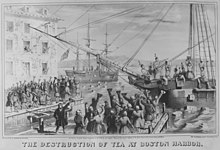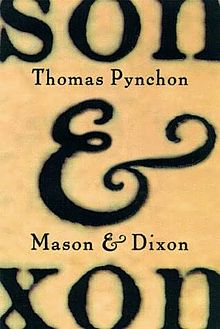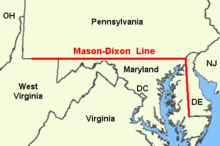Mason & Dixon
Mason & Dixon is a 1997 historical novel by the American author Thomas Pynchon , the central theme of which is the drawing of the Mason-Dixon Line , the border between Pennsylvania and Maryland , by the British surveyors Charles Mason and Jeremiah Dixon in the years 1763 to 1767 . While most of the novel traces the work of the two main characters in America, shorter episodes are also set in Great Britain , St. Helena , the Cape Colony, and the Atlantic Ocean . Mason & Dixon was Pynchon's fifth novel and, like all of his works, is located in postmodern literature . When it was published, the novel met with a wide response, especially in the American press, but, unlike most of Pynchon's other works, it did not win any literary prizes . The German translation by Nikolaus Stingl was published in 1999 and was awarded the Paul Celan Prize in 2007 .
action
Mason & Dixon is divided into three episodes of different lengths, which in turn are divided into a total of 78 chapters.
The first part, Latitudes and Departures (dt .: longitudes and risers ), mainly dealt with Mason and Dixon's trip to the Cape Colony in South Africa to observe a Venus transit - a passage of Venus in front of the sun in 1761. This trip is the first joint project of both. At the Cape of Good Hope they find accommodation with the Dutch Vroom family - and are confronted for the first time with slavery , which will play an important role in the further course of the book. In October of the same year they traveled on to St. Helena , where they met Nevil Maskelyne , a member of the Royal Society and later British court astronomer . On their return to England, Mason and Dixon accept an assignment from landowners in Maryland and Pennsylvania to precisely measure the border between these two colonies .
The second and by far the longest section of the novel, America , describes their stay in America and the surveying of this very border between 1763 and 1768. Mason and Dixon are out there with many helpers - land surveyors, auxiliaries, forest workers and strange characters who are in their Join in the course of the trip. Wicks Cherrycoke, the novel's narrator, is also one of her companions. In America, Mason and Dixon gradually gain great popularity, which leads to encounters with contemporary greats such as Benjamin Franklin or George Washington . The goal is to draw a geometrically completely straight line between the two colonies, which overrides geographical conditions - in forests that lie on their way, aisles are cut, in one case even a house is divided by the line. Mason and Dixon's slow progress towards the west is repeatedly interrupted by various insets in the narrative. People they meet tell their stories, companions from different cultures tell legends, and there are always long dialogues between the two main characters, in which they reflect on the social situation in America shortly before the War of Independence . Mason is visited again and again by the ghost of his late first wife Rebekah, who reflects on his deeds. Increasingly, Mason and Dixon question their own activities as they witness slavery, oppression and massacres of the indigenous people more or less directly related to the drawing of their lineage. Eventually, although they are no longer clear to themselves about the reasons for this, they still bring it to an end.
The third and final part load Transit , (dt .: Last passage ) treats the events between the return of the two protagonists to England in 1768 and Mason's death and emigration of his children to America. In 1769, Mason and Dixon observed another Venus transit, this time independently. An important event towards the end of the novel is Dixon's visit to the interior of the Hollow Earth , a kind of underworld trip . The hollow world theory is representative of scientific theories that, with the spread of rationalism, increasingly no longer have a place in the human worldview. The inhabitants of the earth's interior make Dixon aware of the problem of this loss of imagination in the context of the Enlightenment . After Dixon's death in 1779, Mason begins to build better relationships with his family and especially his children. Rebekah's ghost no longer appears to him. The novel ends with the decision of Mason's children to go to America and live there - they only know the New World from the stories of their father and have from it the image of a Promised Land .
Fabrics and motifs
The boundary line
The Mason-Dixon line as a boundary line fulfills important functions in three different directions. In the east-west direction, it reflects the course of settlement in North America and the cartographic development of unknown areas; in north-south direction it leads to a division of the country, which eventually in the 19th century in the American Civil War peaked; their measurement with astronomical methods can also be seen as a connection between heaven and earth, which is also reflected in the figure constellation with the astronomer Charles Mason and the land surveyor Jeremiah Dixon. The perfect straight line, which is not based on local conditions, is regularly associated in the novel with the advance of rationalism and the Enlightenment and is usually strongly separated from natural phenomena. Only in very few places within Mason & Dixon do straight lines appear as non-human-made phenomena (e.g. in connection with lightning strikes); They are then always perceived as threatening by their observers and placed in religious and metaphysical contexts. What all these lines have in common is their perception as an anomaly.
In its capacity as a dividing line between the later northern and southern states , the Mason-Dixon line also reflects political power structures. Different laws apply to the north and south of the line, the areas of application of which are only clearly defined by the work of the protagonists . The central example of this is slavery. Mason and Dixon are initially unaware of this dimension of the line. When they recognize the problem over time, they still fail to see through the underlying power structures. Feeling that they are being instrumentalized, they increasingly question their work and look for reasons and justifications for their work for themselves. All conceivable reasons are ruled out over time, even financial motivation. At the end of this process of development of the figures, there is no other insight than that, as surveyors, they draw lines because they are surveyors.
Colonialism and slavery
Colonialism and slavery are topics that are dealt with in different ways in the novel. Sometimes Mason and Dixon are directly confronted with these phenomena, for example during their stay in the Cape Colony; sometimes their products, often consumer goods , appear incidentally in the plot and are not reflected further by the characters.

The city of Philadelphia as the first port of call for Mason and Dixon in America plays a special role in this context. On the one hand, at the time of the protagonists' arrival, it is still part of a British colony striving for independence; on the other hand, it benefits greatly from this same colonialism: In Mason & Dixon , it is represented as a metropolis full of coffee shops and grocery stores, which is full of consumption and trade is shaped. Among others, Benjamin Franklin introduced Mason and Dixon into this world.
Various foods of colonial origin appear again and again throughout the novel. Most noticeable is the frequent appearance of coffee , which plays a particularly political role: in 18th century America it increasingly replaced tea , on the one hand as a symbolic emancipation from the British colonial power, on the other hand for reasons of cost because of the high British taxes on tea . In the novel, Mason, who values his social status in England, is portrayed as a tea drinker, while Dixon, who adapts more to American consumer behavior, is a coffee drinker. Although both protagonists are opponents of slavery , they are not aware of the problem of the coffee harvest by slaves.
Towards the end of the novel, Jeremiah Dixon undertakes a striking action that has also been passed down historically: at a slave market he snatches the whip from a trader with which he beats a slave and beats the trader himself. However, this represents a rather helpless symbolic act: Dixon does not come to a deeper understanding of the balance of power.
History and fiction
A recurring theme is the nature of history and how it differs from fiction . Especially in the framework narrative about Reverend Wicks Cherrycoke, this contrast between different characters is often discussed directly and controversially, which gives the entire novel a strong metafictional element. Cherrycoke himself takes the view that a clear separation of history and fiction is not possible. He sees it as a task of historians to search for facts, but also as their duty to keep the "truth" secret; Like fiction, history can only ever be conveyed in narratives that are in turn subject to the interests of the narrator. This makes telling history per se a political act and is better off in the hands of the poets than in those of those in power. There is no logical, linear course of history for Cherrycoke; rather, it consists of a multitude of parallel and interwoven strands that cannot be summarized in an overarching concept.
Other characters, however, represent a strict separation between fact and fiction, whereby Plato's view of the poet as a liar plays a central role. The historical background of Mason & Dixon must be kept in mind; the novel is set in an era in which the rise of the novel to the leading literary genre took place and sparked major discussions about the importance of fiction. The falsification of historical facts and the portrayal of false role models was seen as having great potential to endanger young people. In the novel, this position is represented by Ives LeSpark, who refuses to read his children and is also suspicious of Cherrycoke's stories.
Narrative
Mason & Dixon is linguistically in the style of the 18th century, with Pynchon imitating various genres of the time. An important point of reference is the language of Charles Mason's historical diaries, which he also copied in their epoch-atypical peculiarities. Pynchon consistently uses the vocabulary of the 18th century, some of which is no longer familiar to native English speakers, and the contemporary spellings of the vocabulary. In the original English version, nouns are mostly capitalized . This pastiche is sometimes used for strange effects. Pynchon uses unknown vocabulary today, the existence of which sounds improbable in context and which seem to parody modern words (such as the word "ketjap"), but which can be historically proven.
Several narrative levels overlap throughout the novel. Reverend Wicks Cherrycoke tells the story of Mason and Dixon in a frame narrative set around Christmas 1786 (Mason's death year) in Philadelphia. Cherrycoke finds himself in a similar situation to Scheherazade : as long as he entertains the children of his brother-in-law's family with the story, he enjoys his hospitality. An omniscient narrator stands above this general plot , whose narrative voice mixes with Cherrycoke's voice, which in some cases reaches a level at which the voices become indistinguishable. In addition, countless stories from other characters are woven into this structure.
Historical documents are integrated into the novel in many places. Some of these are authentic historical sources that Pynchon correctly cites, but some of the “documents” are themselves fictitious. A simple distinction is often not possible for the reader. This results in a permanent uncertainty as to whether what has just been read is fact or fiction , which ultimately also problematizes the possibility of historical knowledge itself. Fairy tales and folk tales are also processed in this way and in some cases retold in great breadth - for example, the story of the legend of the Lambton worm by Jeremiah Dixon takes up an entire chapter. This stylistic device is typical of the genre of historiographical metafiction to which Mason & Dixon is often assigned.
reception
The novel caused quite a stir in the press even before it was published. The publisher ran an unusually elaborate for a literary work advertising campaign in newspapers, television and public placarding, but were out of the title and the later blurb no further information award. Half a year before publication, Ron Rosenbaum wrote a "preliminary review" in the New York Observer , in which, based solely on this information, he made some reflections on how Pynchons deal with the subject of Mason and Dixon. Rumors had circulated since The End of the Parable was published in 1973 that Pynchon was working on a novel based on this material. Mason & Dixon was published with an initial circulation of 200,000 copies, but did not stay on the bestseller lists for long and could not meet the publisher's commercial expectations.
The response in the press after the novel was published was largely positive. Many critics attested Pynchon a maturation compared to his earlier works. In the Los Angeles Times , Ted Mooney highlighted the psychological complexity of the two main characters after poor figure drawing had been one of the main criticisms of many reviewers of Pynchon in the past. Less positive reviews especially emphasized the excessive complexity of the novel. Pynchon's postmodern linguistic bias was seen as too academic and ultimately reader unfriendly. Pynchon's handling of post-colonialism was also criticized: Michael Berubé accused him of being a “consensus critic of the consensus”, precisely because of his portrayal of slavery, colonialism and oppression from a standpoint that was apparently independent, but in truth had long since been taken over by the mainstream To support stereotypes and the national identity of America against which he appears to be writing.
Mason & Dixon experienced a broad reception within literary studies . Within a few years, numerous monographs , collections of articles and dissertations dealing with the novel were published. The biennial International Pynchon Conference took place in 2004 based on one of the most important motifs of the novel on the occasion of the Venus transit to Malta .
There is an adaptation of the novel in pop music: the Scottish guitarist Mark Knopfler and his duet partner James Taylor slipped into the roles of Mason and Dixon on the title track of Knopfler's album Sailing to Philadelphia in 2000 , which Knopfler claims to have brought about through reading the novel has been.
Individual evidence
- ^ David Foreman: Historical Documents Relating to Mason & Dixon , in Horvath / Malin (2000), p. 160
- ^ Sigvardson (2002), p. 91
- ↑ cf. Colin A. Clarke: Food and Sacrament in Mason & Dixon , in: Hinds (2005), pp. 77-98
- ^ A b David Foreman: Historical Documents Relating to Mason & Dixon , in Horvath / Malin (2000), p. 147
- ↑ a more detailed explanation of this fact can be found in Kopp (2004), p. 84 ff.
- ↑ Cf. Cherrycoke's reflections on history, which are the motto of the 35th chapter by Mason & Dixon .
- ↑ Kopp (2004), p. 86.
- ^ David Foreman: Historical Documents Relating to "Mason & Dixon" , in Horvath / Malin (2000), p. 148
- ↑ Louis Menand: Entropology , reviewed in the New York Review of Books (1997) , viewed September 1, 2009
- ↑ Ickstadt (1999), p. 558
- ^ David Foreman: Historical Documents Relating to Mason & Dixon , in Horvath / Malin (2000), p. 162
- ↑ Kopp (2004), p. 82 ff.
- ↑ Ickstadt (1999), p. 555
- ^ Henry Holt & Company Press Release , viewed September 1, 2009
- ↑ Ted Mooney: Thomas Pynchon's Mason & Dixon , viewed September 1, 2009
- ^ Brooke Horvath, Introduction , inHorvath / Malin (2000), p. 12
- ↑ Pedro Garcia-Caro: American Exceptionalism and Geographic Politics , in: Hinds (2005), p. 106
- ↑ Interview with Mark Knopfler in the music magazine Facts , seen on September 1, 2009
literature
expenditure
- Thomas Pynchon: Mason & Dixon (German by Nikolaus Stingl). Rowohlt, Reinbek 1999, ISBN 3-498-05292-6
- Thomas Pynchon: Mason & Dixon , Vintage, London 1998, ISBN 0-09-977191-8 (English original edition)
Secondary literature
- Brooke Horvath, Irving Malin (Eds.): Pynchon and Mason & Dixon . Associated University Press, Cranbury / London / Mississauga 2000, ISBN 0-87413-720-9
- Heinz Ickstadt: Haunted by Ghosts of a Dream: Thomas Pynchon's "Mason & Dixon" , in: Amerikastudien (1999) 44 no.4, pp. 555-568.
- Manfred Kopp: Triangulating Thomas Pynchon's Eighteenth-Century-World: Theory, Structure, and Paranoia in "Mason & Dixon" . The Blue Owl, Essen 2004, ISBN 3-89924-107-X
- Joakim Sigvardson: Immanence and Transcendence in Thomas Pynchon's "Mason & Dixon" . Almquist & Wiksell, Stockholm 2002, ISBN 91-22-01962-6
- Elizabeth Jane Wall Hinds (Ed.): The Multiple Worlds of Thomas Pynchon's "Mason & Dixon" . Camden House, Rochester / Woodbridge 2005, ISBN 1-57113-318-6


